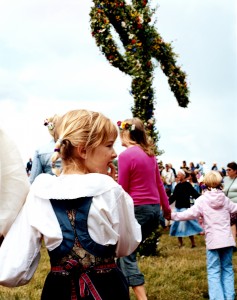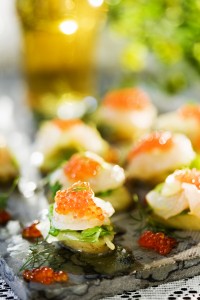Scandinavian Midsummer: Feast the Night Away
- At June 13, 2011
- By Katherine
- In News, Recipes
 4
4
I’ve had a life-long love affair with Sweden, its culture, cuisine, and people. I’m so grateful that finally the world has caught on that my beloved Sweden is a recognized culinary destination.
Swedish cuisine is the ultimate “nouvelle” cuisine. It is simple, fresh, and is naturally local and seasonal. It’s elegant, yet down-to-earth, which is also a perfect description of the Swedish people, and even Swedish design.
The daughter of a Swedish mother and an American father, I’ve been visiting Sweden since a little girl. During my regular visits, I soaked in every possible aspect of Swedish food and cooking. I took many fishing trips in the Baltic Sea on my Uncle Olle’s small motor boat. I received early lessons on cleaning, smoking, grilling, pickling – and any method one could name – of preparing fresh fish.
I was raised in the Swedish culinary tradition. I’ve picked wild blueberries, strawberries and mushrooms in the Swedish archipelago, then watched as my grandmother (mormor) and Aunt Ingrid prepared treats with the bounty. Growing up, I and my mother dined regularly on crepes with lingonberries and cream – one of my favorite dinners (though now I use yogurt instead of cream! Naturligtvis!). I’ve delighted in all the unique foods my family introduced me to: the grainy rye breads, the special cheeses and yogurts, the smoked reindeer meat, the delicate, sweet, and tiny Swedish shrimps, caviar, crayfish, and of course, meatballs and lingonberry sauce!
If you are not a Swede or Scandinavian, you may not know that summer is the most special time of year. For weeks on end the sun never sets in Sweden’s summertime. It’s daylight round-the-clock.
Every year, during one of those “white nights” – the Friday nearest the 24th of June – the nation turns out to feast until morning. After long winter months of what seems like never-ending darkness, sun-starved Swedes join the rest of Scandinavia in celebrating the summer solstice – the year’s longest day.
Swedes call the celebration Midsummer Eve.
 It is more than just a holiday, however. Midsummer Eve, often lasting through Saturday – and sometimes the whole weekend – is the national excuse for the biggest parties of the year. The revelry is non-stop.
It is more than just a holiday, however. Midsummer Eve, often lasting through Saturday – and sometimes the whole weekend – is the national excuse for the biggest parties of the year. The revelry is non-stop.
Beginning Friday morning, families gather to set the scene. Every spare piece of furniture is moved outdoors, setting up a festival atmosphere. Large wooden crosses are turned into maypoles decorated with flowers, ribbons and leafy branches.
The maypoles are raised, and hours of dancing, singing and community wide camaraderie get under way. By late afternoon the revelry has served its purpose. Gnawing hunger has prepared the celebrants for the main event: the feast, Sweden’s famed smorgasbord.
Smorgasbord is a Swedish invention and is literally a table of open-faced sandwiches. Though its origin was a simple array of hors d’oeuvres, smorgasbords today are exhaustive buffet-style spreads, the Swedish version being the best known.
There are appetizers, salads, main courses and desserts. The dishes signal summer’s first harvests: freshly clipped dill, tender root vegetables, fish and other seafoods, and strawberries grown in the country.
There are cured ingredients, as well. Pink rolls of cured salmon are wrapped around dill sprigs, with yellow mustard sauces and peppercorns alongside. There is marinated herring and coarse salt, as well as dill and other pickles. Dairy products also are important, including eggs, cheese and cream.
The traditional drink is aquavit, Swedish vodka spiced with anise and caraway. It is served in tiny schnapps glasses. The Midsummer toast, which loses something in translation, usually amounts to a unanimous gulp followed by a chant of “rah, rah, rah, rah.”
Actually, preparation of Midsummer food usually begins a couple of days before. Local fishermen stack their just-caught salmon in rickety wheelbarrows, roll them into town and go door to door displaying their wares for inspection by anxious cooks.
The fish are carefully examined in solemn transaction, the cook – usually my Grandmother – signaling the final selection with an abrupt, “This will do!” The fisherman nods, satisfied, and carries the fish to the kitchen where it lands on the table with a thud. The smell of the sea enters the house with the day’s catch. The best knife has been sharpened for this moment: the start of Midsummer Eve cooking.
Aquavit and Marcus Samuelsson’s Gravlax Club Sandwich
Gravlax and Mustard Sauce
For more fabulous tips and simple, effective ways to lose weight,
buy her book, Diet Simple!











Meredith &n Ingvar Torstensson
Hi Katherine,
We have read your article about Midsummer in Sweden and we really liked it. I am glad you writing about Swedish cuisine which these days is gourmet eating in many restaurants. We have several Michelin restaurants.
Just a correction. Olle fish in the Baltic Sea not in the North Sea.
When i make my gravlax I always have two pieces of salmon. In the baking pan I start with dill then one piece of salmon with skin down. Both sides rubbed with the mixture. Then dill again on the bottom salmon. On top the other piece of salmon with the mixture on both sides with skin up. And then dill again. Always plenty of dill. Then in the refrigerator. I let my mine be in the fridge for at least 48 hours and many times 72 hours. I turn the salmon every 24 hours.
I am going to Sweden and Grimson on Saturday for 6 weeks to see my son and family and all my relatives. I will bring the article with me and show it to everybody on the island. And also to Olle & Ulla who visit the island often
Again thanks for an interesting article.
Ingvar
Katherine
Dearest Ingvar,
Thank you so much for correcting me. I have changed the North Sea to the Baltic! Also, I really appreciate the lovely description of your cooking techniques!
Dolores Kostelni, Sr. Restaurant Reviewer, The Roanoke Times
Katherine, I loved your descriptions of summer solstice and the Midsummer Eve festivities with all of the first-harvest bounty set out for the celebratns,and all the foods you enjoyed during your trips to Sweden. Lovely. It sparked my memories when I was young and my mom would take me to a restaurant, Taste of Sweden, in a small New Jersey town near us that had been settled by Swedes and Scandinavians, where we feasted and danced–memorably. Thanks for giving me a delicious opportunity to recall those days and times when we all relished the salmon, cucumbers in dill and sour cream, my introduction to lingonberries, all extraordinary moments. My mom, vivacious with her friends and I, having a ball with their children. Your essay is beautiful, keep them coming.
Dolores Kostelni
Katherine
Dear Dolores,
Thank you for sharing your lovely memories!
Katherine